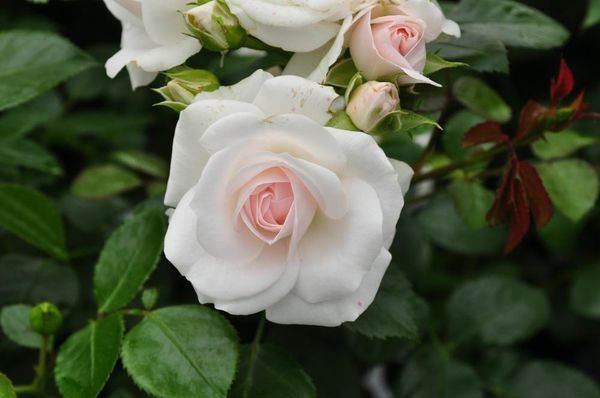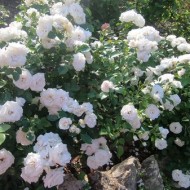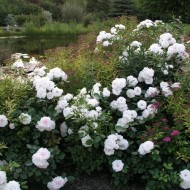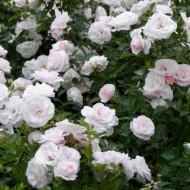How to achieve abundant and full blooming of the Aspirin rose
Content
Features of the variety
The value of a rose and the demand for it depend on varietal characteristics, characterized by such indicators as the size of the bush, the duration of flowering, the external description and the aroma of the buds.

Video "Secrets of spring rose care"
In this video, an expert will tell you how to properly care for a rose in the spring.
Description of the bush
Aspirin Rose - this is the original name of the variety. Like all representatives of the Floribund, it combines the characteristics of several species.
Aspirin belongs to the groundcover class, but is also grown as a miniature rose or semi-pebbled scrub. The confusion arose due to the fact that the bush is rather compact, short (50–80 cm) and well branched. Shoots are flexible, inclined to the ground and intertwined with each other. The leaves are small, dark green, with a glossy surface.
Flowering features
The variety belongs to the category of abundantly and repeatedly flowering, since flowering lasts continuously for 5 months - from early June to October frosts. Up to 15 buds are formed on one peduncle. They bloom at the same time, which is why the bush expands and turns into a fragrant pinkish-white cloud. The change of inflorescences occurs constantly: withered flowers crumble themselves, and fresh ones open in their place.
Aroma and decorative characteristics of buds
The buds are lush and large, up to 8-9 cm in diameter. Each flower consists of about 50 velvety petals of different structures and shapes. The main color of the rose is white, at the beginning of flowering, the middle is painted in a pinkish tint, which appears brighter in cool weather. Over time, this shade fades, and the buds acquire a pure snow-white color. The scent of a rose is mild, unobtrusive and pleasant.
Winter hardiness and drought resistance
The description of the variety indicates that the bushes are able to withstand frosts down to -29 ° C, so in the climate of the middle zone they feel more than comfortable. Despite this, it is still recommended to cover the rose in winter for reinsurance. But the variety is quite susceptible to high temperatures. The optimum air temperature for a rose is considered to be +24 ° C. When the degree rises to +27 ° C, the growth of the bush begins to slow down, and the buds are formed in fewer quantities.
- Aspirin Rose - this is the original name of the variety
- Rose Aspirin appeared in 1997
- The variety belongs to the category of abundantly and repeatedly flowering
Advantages and disadvantages of the variety
This variety is popular with gardeners, as evidenced by their positive reviews. Among the many advantages of a rose, they distinguish:
- excellent winter hardiness - for wintering, a light shelter is enough for her;
- immunity to pests and fungal diseases;
- the ability of the bushes to cleanse themselves - the rose petals themselves crumble before they dry up, due to which the bush always looks neat;
- delicate color and large bud size;
- the ability of the rose to tolerate shading and the absence of the sun;
- the possibility of versatile use in landscape design.
The rose has no significant flaws. Its only requirement is high-quality and fertile soil. If the bush is planted in poor soil, frequent feeding will be required for lush flowering.
Features and growing conditions
This variety is considered unpretentious, but there are some nuances that need to be considered when growing these beautiful flowers.
Landing subtleties
An ideal place for a rose is an open area on a hill where there is no groundwater nearby. Gusts of wind can ruin the delicate buds, so planting bushes is better against a wall or fence.
The soil needs fertile and warm. Therefore, the planting time depends on the climate of the region: where the winters are warm, you can plant a rose in the fall, in regions with frosty winters, it is better in the spring. The planting process is standard. It is necessary to take into account the nuance that the root collar of the bush should be 2-3 cm below the soil level.
Requirements for watering and feeding
Water the rose if the soil has dried to a depth of 4–5 cm. Watering is carried out early in the morning or in the evening so that the moisture evaporates less. The frequency of watering is set individually, the approximate water consumption is 5–6 liters per adult bush.
For abundant flowering, you need at least 4 dressings per season. The first is carried out in early spring, when the leaves are just beginning to form. For her, universal fertilizers are used: Agricola-Aqua, Gloria, Pacon, Citovit.
The second feeding is carried out in a month, the third - at the end of the first wave of flowering. Fertilizers are used the same - they perfectly stimulate the bush to lay new buds. For the last, autumn feeding, potash fertilizers are used, which accelerate the ripening of the shoots.

Mulching and soil care
To prevent the bush from getting sick, you must always keep the trunk circle clean, because weeds are a haven for fungi and insect larvae. While the plant is young, it is required to regularly weed and loosen the soil around the rose. After a couple of years, the shoots will intertwine and suppress the growth of weeds. It is also recommended to mulch the soil around the bush with organic matter: straw, wood shavings or chips. A layer of mulch not only retains moisture, but also serves as a decorative decoration.
Flower pruning
Pruning of bushes is carried out twice a season: in spring - sanitary, in autumn - formative. Also in the spring, it is recommended to do preventive pruning of recovered and weakly flowering varieties. Old and diseased bushes are cut to 2-4 buds, to stimulate flowering - up to 5-7 buds. Autumn pruning involves removing all damaged branches and shortening healthy ones by 10-15 cm to give the bush a beautiful shape.
Preparing for winter
This process consists of several stages:
- hilling the root zone to a height of 15–20 cm;
- bending branches and covering with spruce branches;
- dry shelter structures.
The frame for the shelter is made of wire, taking into account the height of the bush, a non-woven material is stretched over it, allowing air to pass through. If film is used, cuts must be made. The bush is closed when frosts from 7 to 10 ° C last for a week.
Do not rush to cover the rose until a stable frost is established. The temperature drop causes more damage to it than a slight frost.
Use of Aspirin rose in garden design
Due to its long flowering, the rose is widely used in landscape design.Low bushes fit perfectly into any flower arrangement, be it a flower bed, a rose garden or a multi-level garden. Often they are planted in groups, creating a fabulous atmosphere on the site with a luxurious flowering.
Designers use these roses to decorate lawns, garden alleys, inclined flower beds, and plant them in the foreground of rose gardens. Flexible, profusely flowering shoots can be tied to supports or create a hedge, and the snow-white color of the buds is in perfect harmony with all flowers and complements any style.

Gardeners reviews
“This variety has become my favorite. The flowering bushes are in great harmony with the green lawn and refresh the area. "
“The color of the rose, as for my taste, is not very expressive, but for the long flowering it can be forgiven. Without special care, the bush blooms continuously until autumn and does not get sick with anything. "
From all this, we can conclude that Aspirin is a versatile variety that is suitable for any region. It does not freeze, is resistant to disease and blooms all summer long, creating an unforgettable comfort on the site.



